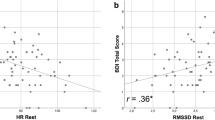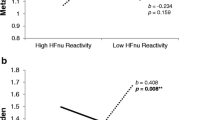Abstract
The left ventricular ejection fraction (EF) was studied in 17 healthy volunteers with a new ambulatory left ventricular function monitor. Heart rate, EF, and blood pressure measurements were made during rest, a psychiatric stress interview, cold exposure, exercise, and eating. An increase in EF was seen during emotional stress (from 0.45±0.09 to 0.51±0.13, P<0.001). This increase was comparable to that observed during exercise (0.52±0.14) and eating (0.52±0.10, P<0.001). In contrast, cold exposure caused a decrease in EF (0.43±0.13, P<0.05). These observations demonstrate the powerful hemodynamic consequences of common behaviors as well as the utility and feasability of studying such behavioral factors in ambulatory subjects.
Similar content being viewed by others
References
Bonelli J (1982) Stress, catecholamines and beta-blockade. Acta Med Scand 660:214–218
Brown JM, White CJ, Sobol SM, Lull RJ (1983) Increased left ventricular ejection fraction after a meal: Potential source of error in performance of radionuclide angiography. Am J Cardiol 51:1709–1711
Buell J (1984) Impedance cardiography and plethysmography. In: Herd J, Gotto A, Kaufmann P, Weiss S (eds) Cardiovascular Instrumentation: Proceedings of the Working Conference of Applicability of New Technology to Biobehavioral Research. NIH Publication 84:1654, pp 227–238
Callahan R, Froelich JW, McKusick KA, Leppo J, Strauss HW (1982) A modified method for the in-vivo labeling of red blood cells with Tc-99m. J Nucl med 23:315–318
Figueras J, Singh BN, Ganz W, Swan HJ (1979) Hemodynamic and electrocardiographic accompaniments of resting postprandial angina. Br Heart J 42:402–409
Forsman L, Lindblad LE (1983) Effect of mental stress on baroreceptor-mediated changes in blood pressure and heart rate and on plasma catecholamines and subjective responses in healthy men and women. Psychosom Med 45:435–445
Groen JJ, Hansen B, Herrmann JM, Schafer H, Schmidt TH, Seldmann KH, von Vebkull T, Weckmann P (1982) Effects of experimental emotional stress and physical exercise on the circulation in hypertensive patients and control subjects. J Psychosom Res 26:141–154
Houben H, Thien T, Wijnands G, Vant Laar A (1982) Effects of cold exposure on blood pressure, heart rate and forearm blood flow in normotensives during selective and nonselective beta-adrenoceptor blockade. Br J Clin Pharmacol 14:867–870
Lazewatsky JL, Alpert NM, Moore RH, Boucher CA, Strauss HW, Entire G, Charey R, Schreiner R (1980) A CdTe ambulatory ventricular function monitor. IEEE Trans Nucl Sci 27:524–528
LeBlanc J, Cote J, Jobin M, Labrie A (1979) Plasma catecholamines and cardiovascular responses to cold and mental activity. J Appl Physiol 47:1107–1111
Moore RH, Zielonke JS, Wilson RA, Sullivan PS, Alpert NM, McKusick KA, Boucher CA (1983) The Vest — Description of the instrument and initial validation: A device for the ambulatory measurement of ejection fraction. Emission Computed Tomography 5:263–274
Okada RD, Boucher CA, Strauss HW, Pohost GM (1980) Exercise radionuclide imaging approaches to coronary artery disease. Am J Cardiol 46:1188–1204
Pickering T, Harshfield G, Kleinert H, Blank S, Laragh J (1982) Blood pressure during normal daily activities, sleep and exercise. JAMA 247:992–996
Stern S, Tzivoni D (1974) Early detection of silent ischemia heart disease by 24-hour electrocardiographic monitoring of active subjects. Br Heart J 36:481–486
Taylor DN, Garvie NW, Harris D, Sharratt GP, Goddard BA, Ackery DM (1980) The effect of various background protocols on the measurement of left ventricular ejection fraction in equilibrium radionuclide angiography. Br J Radiol 53:205–209
Wagner HN, Wake R, Nickoloff E, Natarajan TK (1976) The nuclear stethoscope: A simple device for the generation of left ventricular volume curves. Am J Cardiol 23:747–750
Wilson RA, Sullivan PJ, Moore RH, Zielonski JS, Alpert NM, Boucher CA, McKusick KA, Strauss HW (1983) An ambulatory ventricular function monitor: Validation and preliminary clinical results. Am J Cardiol 52:601–606
Author information
Authors and Affiliations
Additional information
Supported in part from grants HL24623 and HL36005 from the National Institutes of Health and by fellowships from the Canadian Heart Foundation (Dr. Kiess) and the Medical Research Council of Canada (Dr. Liu)
Rights and permissions
About this article
Cite this article
Kiess, M.C., Dimsdale, J.E., Moore, R.H. et al. The effects of stress on left ventricular ejection fraction. Eur J Nucl Med 14, 12–16 (1988). https://doi.org/10.1007/BF00252610
Received:
Issue Date:
DOI: https://doi.org/10.1007/BF00252610




